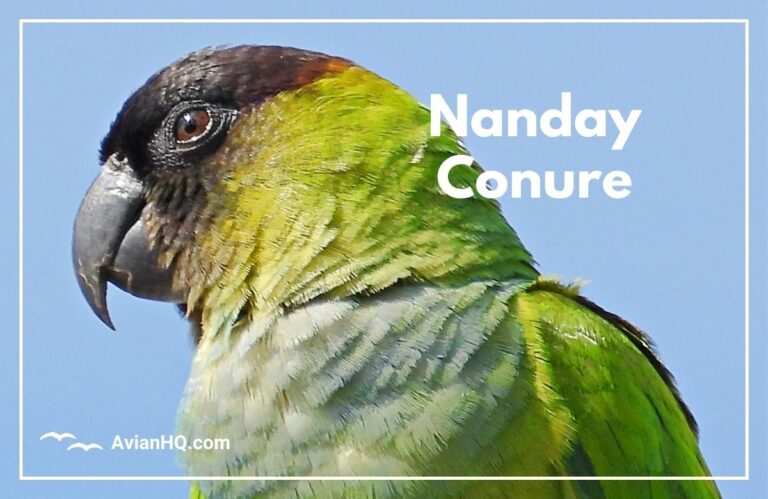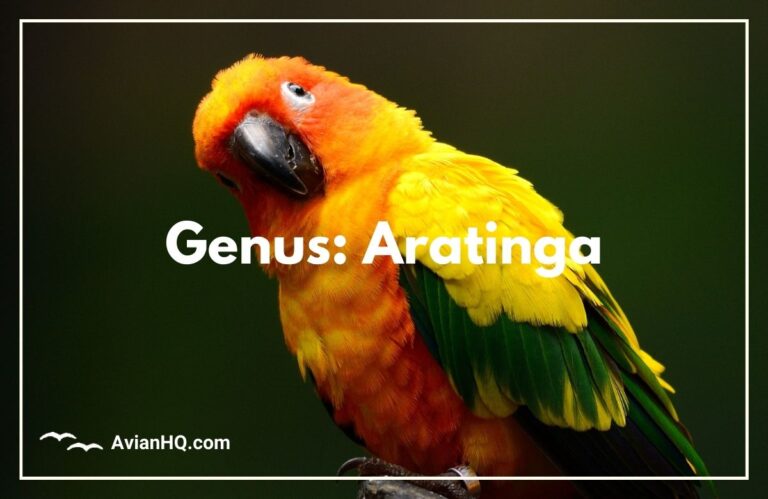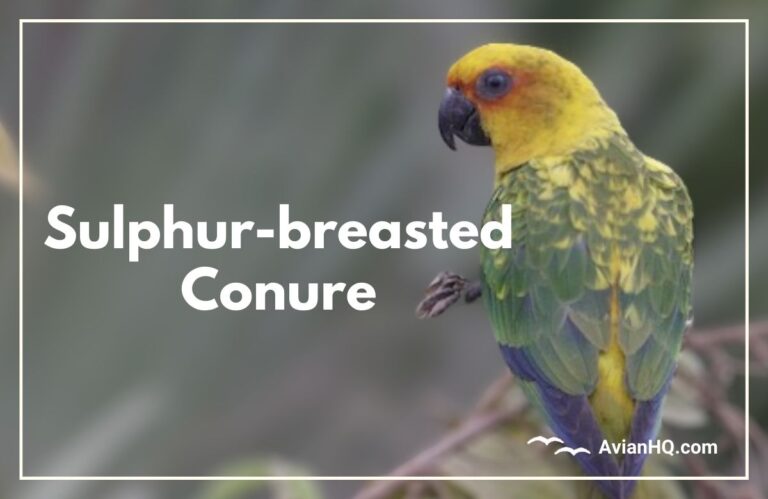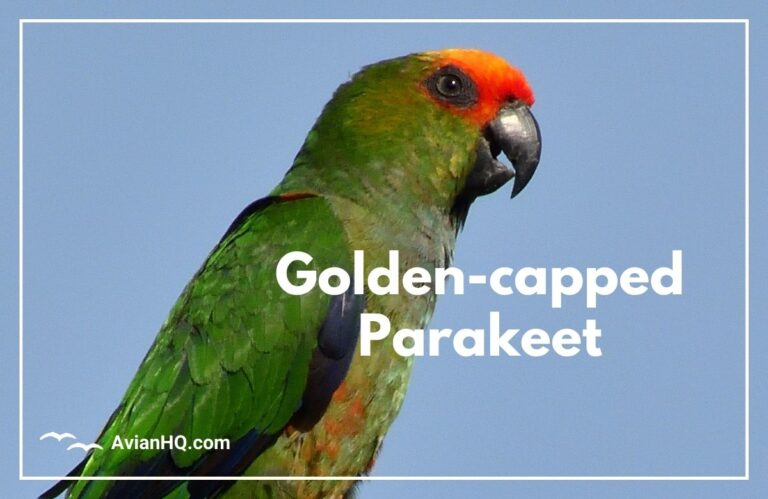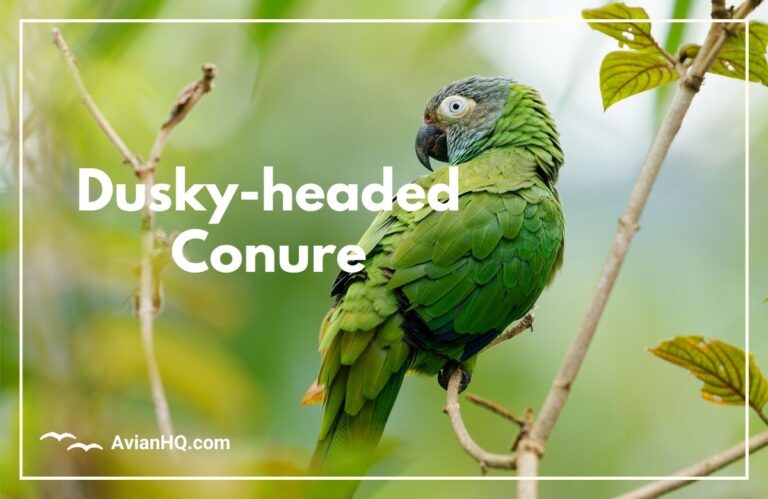Sun Conure (Aratinga solstitialis)
Have you ever seen a small parrot with bright golden feathers, an orange breast, and a strongly hooked black beak? If so, you may have spotted the sun conure, one of the most radiantly colored birds in the parrot family.
With their vivid tropical colors and loud, chatterbox voices, sun conures make a big impression despite their small size. These parakeet-sized parrots measure only 10-12 inches (27-30 cm) long on average, with a weight of 3-5 ounces (90-120 grams). Yet their brilliant plumage ensures they stand out in any environment.
Sun conures originate from northeastern South America, inhabiting the forests, woodlands and savannas of the Guianas, Venezuela, Colombia and Brazil. Here they form bright, raucous flocks that spend their days nosily foraging for fruit, seeds, nuts and insects to eat.
Their scientific name, Psittacara solstitialis, references their radiant golden coloration. Psittacara identifies them as parrots, while solstitialis comes from the Latin term for the summer solstice – aptly comparing these birds to the bright, vibrant essence of summer.
In captivity, sun conures are extremely popular as pets due to their striking colors, playful nature and ability to learn tricks and words. However, perspective owners should be aware that these intelligent parrots demand constant attention and stimulation. In the wild, their conservation status is currently of Least Concern – but habitat loss puts pressure on some populations.
This article will cover everything you need to know about these dazzling yellow delights of the parrot family, from their origins and taxonomy to conservation, behavior and cultural significance. Let’s start by going back through the history of how Western scientists first discovered sun conures.
History and Taxonomy
Sun conures first entered Western science in 1758, when the pioneering Swedish naturalist Carl Linnaeus classified them for the first time. Linnaeus assigned these vibrantly colored parrots to the genus Aratinga, grouping them with other small New World parakeets. At this time, their species name became Aratinga solstitialis – with solstitialis meaning “of the summer solstice” in Latin, comparing the birds’ golden plumage to the bright essence of summer.
For over two centuries, sun conures remained classified in the genus Aratinga. However, increasing understanding of parrot genetics and evolutionary relationships led to a reclassification. In 1997, the species was moved to its current genus of Psittacara – identifying it as one of the smaller New World parrots in this group.
There are three recognized subspecies of sun conure:
- Psittacara solstitialis solstitialis – the nominate subspecies found in the Guianas and Brazil
- Psittacara solstitialis jandaya – native to northeastern Brazil
- Psittacara solstitialis conuropsis – occurring in western Venezuela
These subspecies have slightly different coloration and patterning, but can interbreed. Going forward, we’ll focus our discussion on the behaviors and traits of the widespread nominate subspecies, P. s. solstitialis. Now let’s explore the beautiful physical appearance of these stunning parrots.
Physical Appearance
The vibrant colors of the sun conure are undoubtedly its most distinctive physical feature. These small parrots display mostly bright golden yellow plumage on the head, neck, belly and underside of the wings, set off by vivid orange feathers on the breast, wing coverts, rump and tail.
Adult sun conures reach an average length of 10-12 inches (27-30 cm), with a typical weight range of 3.2-4.5 ounces (90-128 grams). Females tend to be slightly smaller than males on average.
The nominate P. s. solstitialis subspecies has a yellow head and neck, an orange breast patch, greenish upper wing coverts contrasting with dark blue flight feathers, and a yellow-orange tail with a green base. The belly also displays some blue scaling or spotting.
The black, strongly hooked beak of sun conures is disproportionately large compared to the head size, an adaptation for cracking hard nuts and seeds. Their eyes are brown or black, set against bare whitish eye rings. Legs and feet are typically grayish in color.
Geographic subspecies show some variation – P. s. jandaya has a more intensely orange breast without scalloping, while P. s. conuropsis has a darker orange-vermillion breast and more yellow scalloping on the belly. But all share the predominantly golden plumage that gives the sun conure its name.
In the next section, we’ll explore the native habitat and geographic range of these radiant parrots.
Habitat and Distribution
The sun conure is native to northeastern South America, with a range encompassing the Guianas, southern Venezuela, eastern Colombia, and northern Brazilian Amazon. They inhabit tropical forests, woodlands, savannas, and mangroves in this region.
The nominate subspecies P. s. solstitialis occurs from the Guianas southward through Amazonian Brazil up to the Branco River. P. s. conuropsis occupies westernmost Venezuela near the Colombian border, while P. s. jandaya lives in coastal northeast Brazil.
Sun conures reside in lowlands up to altitudes of 3,000 feet (900 m) above sea level. They tend to avoid dense rainforests, preferring more open wooded habitats interspersed with clearings for foraging. Parrot expert Joseph Forshaw suggests their bright colors are an evolutionary adaptation to living in sun-dappled forest edges and ecotones.
Beyond their endemic northeastern South American range, feral populations of sun conures have become established from escapes in other regions. South Florida is home to an introduced population descended from former pets, as are parts of Hong Kong and Indonesia. But these non-native colonies remain much smaller than the thriving populations still found in the Amazonian forests.
Next we’ll take a look at the omnivorous diet that has allowed sun conures to flourish across this broad South American range.
Diet and Feeding
In the wild, sun conures are opportunistic, omnivorous foragers – their diet includes fruit, seeds, nuts, berries, buds, and some insects. This varied nutrition allows them flexibility across many habitats and seasonal changes.
Favorite wild foods include palm fruits, citrus fruits like orange and tangerines, figs, mangoes, cashews and brazil nuts. Sun conures use their large, powerful beaks to crack open even the hardest nuts and seeds. Their claws also assist in grasping and tearing open tough fruits.
While fruit often forms a major part of their intake, sun conures need more than sugars – protein and fats from nuts/seeds are essential. Insects can provide an extra protein boost as well. Captive sun conures do best on a high quality extruded food, supplemented with nuts, produce, and some seeds.
Sun conures are highly social birds that gather in small flocks of 6 to 30 individuals to feed. Their bright colors and chronic screeching matches make these feeding flocks hard to miss. Within groups, some submission displays reinforce social bonds – but squabbles can erupt over prized fruits. Their communal nature carries over into all aspects of their life history.
Next we’ll explore sun conure breeding habits, nest sites, and rearing of chicks.
Breeding and Reproduction
Sun conures reach sexual maturity between 2-4 years old. Monogamous mating pairs form strong bonds, often perching or preening closely together. These bonds may persist across multiple breeding seasons.
To nest, pairs seek out a suitable tree cavity, typically high up around 30 feet (10 m) above ground. Both the male and female sun conure help inspect potential nest sites, but the female takes the lead on choosing. The birds don’t build elaborate nest structures, simply relying on chewed wood bits to form a nest cup.
The breeding female lays between 2-4 eggs per clutch, with 3 being the most common. She deposits one egg every 1-2 days, then starts incubating once the last is laid. Meanwhile her mate feeds her, defending the site from intruders or predators.
Incubation lasts 24-25 days before the altricial chicks hatch. Pin feathers emerge within a week, soon followed by the first hints of bright juvenile plumage just under the skin. Both parents share brooding and feeding duties as the chicks grow.
Fledging occurs around 8 weeks after hatching. The young congregate in crèches or communal groups, still depending partially on parental care as they perfect flight skills over the next month. Their bright colors mature to full adult brilliance by around 18 months old.
Now let’s explore some of the behaviors that characterize sun conures when not breeding, including interesting roosting habits.
Behavior and Ecology
Sun conures live in vibrant flocks that reflect the energy and activity levels of these birds. Groups range from just a mated pair up to about 30 birds moving together. Larger roosting aggregations of 100-500 sun conures may form where food is abundant.
Flocks are highly social but also noisy. Various loud screeches, squeals and rasp-like calls punctuate their daily routines. These vocalizations help maintain contact and coordinate activities across their home range.
At night, sun conures adopt an unusual roosting posture – they wedge themselves vertically into tree cavities or hollows, erect with head pointing upward. Up to a dozen may squeeze into one roost hole. Why turn in for the night like feathered sardines stacked in a tube? Scientists think it protects them from predators.
Daily rhythms revolve around maximizing feeding opportunities. Sun conures may travel several miles between roost sites and productive foraging areas. Their strong jaws and beaks allow them to exploit many difficult foods. If they find a bonanza of fruits or nuts, excited flocks chatter loudly to recruit others.
Flocks maintain safety through both group vigilance and mobbing. Sentinel birds keep watch as others feed. And the spectacle of a dozen screaming parrots diving at a predator is enough to give pause even to forest raptors.
Next we’ll take a look at how extensive capture for the pet trade has impacted wild sun conure populations.
Conservation Status
Thanks to their broad range across northern South America, sunny disposition, and adaptability, sun conures are not currently at risk of extinction. The IUCN Red List categorizes them as Least Concern.
However, localized declines due to habitat loss and trapping for the pet trade have led Brazil to list them as Near Threatened. The two Brazilian subspecies P. s. solstitialis and P. s. jandaya face the most pressure, as agriculture eats into the northeastern Atlantic Forests.
Export quotas aim to limit removal of wild sun conures, but illegal trapping continues. While no overall population estimates exist, outbreaks of diseases like psittacine beak and feather disease could severely impact this highly social species.
Ultimately the persistence of healthy sun conure populations comes down to preserving sizes of intact habitat across their range. As habitat fragmentation increases, the odds decrease of sustaining robust flocks of these highly mobile, energetic parrots.
On a brighter note, sun conures remain locally common in some protected forests where endemic palms supply abundant fruit. And their captive popularity helps ensure continued enthusiasm for their conservation in the wild.
Next we’ll explore the cultural significance and symbolism of these radiant yellow parrots.
Cultural Significance
The vibrant colors and vocal exuberance of sun conures have made them more than just another forest bird in the folklore of indigenous South American cultures. Some Brazilian tribes consider them highly symbolic.
In mythology of the Bororo and Bakairi people, the sun conure represents summer, fertility and brilliance. Their feathers and body parts are used in tribal rituals and regalia. Sadly, such spiritual value hasn’t prevented large scale illegal trade of sun conures by tribal members seeking income.
Conures also appear as characters in origin stories for several groups, occasionally portrayed as helpers to a creator god or hero. The Desana people credit conures with guiding the first people to fertile land along the Rio Negro in Brazil through their chatter.
Beyond religious conceptions, sun conures simply inspire awe and joy across many forest communities thanks to their spectacular colors and vocal exuberance. As pets both in South America and globally, their playful personality and willingness to bond deeply with owners cement considerable affection for this species.
Conservationists must tap into these emotional and spiritual connections to motivate preservation of sun conure populations most threatened by the pet trade and deforestation. Their outsized natural and cultural presence demands a secure future.
Conclusion
From their golden plumage to gregarious nature, sun conures light up any forest they inhabit in South America and captivate humans across the world. These small, radiant parrots cram lots of color, sound, and energy into compact bodies.
We’ve covered the natural history of sun conures across many dimensions – their taxonomy and relations to other parrot species, the brilliant physical appearance that gives them their name, omnivorous foraging supporting complex social behaviors, unique communal roosting habits, and finally their cultural symbolism for indigenous peoples.
While not currently threatened overall, habitat loss and illegal capture for the pet trade may endanger local sun conure populations, especially in Brazil’s Atlantic Forests. Their adaptability provides hope, but preserving intact stands of native forest across their range is key.
Sun conures will continue to dazzle both scientists and pet owners with their fiery colors and personalities. If good conservation supports healthy wild flocks, they’ll persist as a radiant reminder of South American biodiversity for centuries to come.
From treetop acrobatics to their sardine-style vertical roosting, we’ve just scratched the surface for fascinating facts about these summer-colored parrots. Their golden glow both symbolizes the vibrance of undiscovered wilderness and lights a path toward protecting such threatened tropical abundance.


